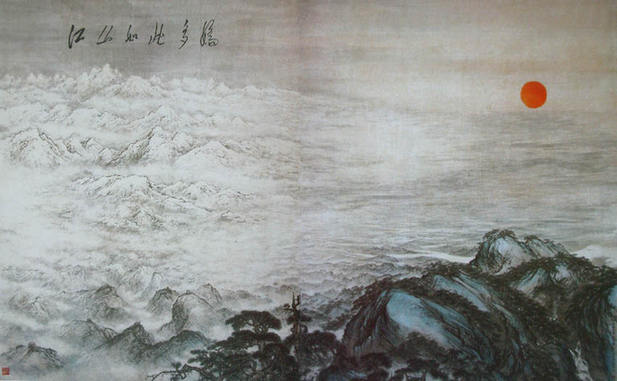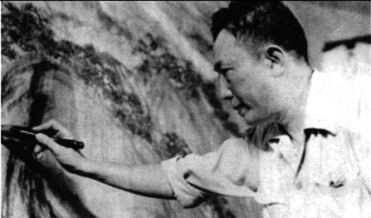| Contemporary Landscape Painting
|
 |
|
This Land Is so Rich in Beauty by Fu Baoshi and Guan Shanyue. |
By staff reporter WU BING
It was the tenth anniversary of the People's Republic of China in 1959 when the Great Hall of the People to the west of Tian'anmen Square was unveiled. As a venue for national leaders to meet their foreign counterparts, the hall needed a large work of art to represent the country. Fu Baoshi (1904-1965) and Guan Shanyue (1912-2000), two of China's most respected and renowned painters, were commissioned to create such a work for the space. Zhou Enlai (1898-1976), premier at the time, identified the theme – a line from Chairman Mao Zedong's poem, "This land is so rich in beauty."
After completing several studies, the two masters finally finished the work two months later. In the painting, the sun is shining over vibrantly green pines. Mountains in the foreground represent South China, and a sea of clouds and snow-capped mountains in the background represent North China. Through the middle run the Yangtze and Yellow rivers that add an integral geographic touchstone to the painting. The work really impressed everyone, including Mao, who agreeably wrote his inspirational line on it.
The painting is nine by five and a half meters in size, and as many as 41 assistants were marshaled to render it. They were divided into several teams to prepare. Some made one meter long brush-pens, and some joined sheets of rice paper together. Another
|
 |
|
Fu Baoshi at work. | special team was in charge of ink-grinding, rubbing ink sticks against inkstones round the clock.
Defying Reason in Ink and Wash
From the perspective of classical Western landscape painting, it's unreasonable to see scenes that are thousands of miles apart in one work. Since Filippo Brunelleschi (1377-1446) invented geometric optical linear perspective, his theory was widely applied in Western studios, giving a spacious and realistic feel to paintings and making landscapes akin to panoramic photography.
But landscape painting in China developed in a quite different way – a viewpoint which can be moved if necessary. The "cavalier" perspective, as some theorists called it, is difficult for Westerners to comprehend.
Even novice Chinese painters were often confused by the technique. Liu Zhenduo, now a mainstay artist, was once among them. In 1963, the 20-something Liu accompanied Fu Baoshi and Guan Shanyue on a field sketching expedition. Fu used to go out in the morning with a sketch book and come back to detail his drawings in the evening. One of these works astonished Liu – a church, apparently Western style, dominating the scene of a Chinese countryside. The church never existed in that area, but Fu explained with delight, "I borrowed it from Romania." Liu suddenly understood landscapes could be composed of scenes amalgamating different places or times. Measured by artistic standards familiar to Westerners, landscapes like Fu's would be characterized as surrealism: symbolic content and romantic theme. This Land is So Rich in Beauty is an excellent illustration of this.
Shrugging Off the World
The scenes in Chinese landscapes are not a literal rendering of specific mountains or rivers, but a painter's personal re-creation. Shi Tao (1630-1724), an artist laying claim to innovation, once said: "I have sketched not one, but all beautiful peaks for my creation."
| 